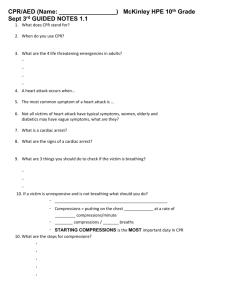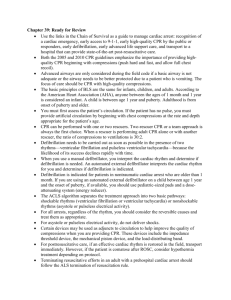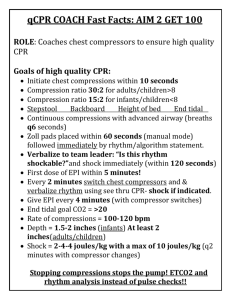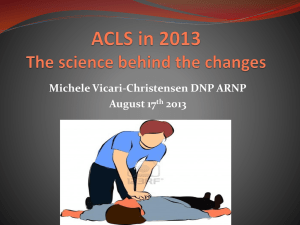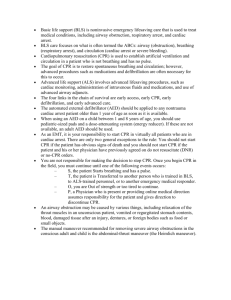PEPP Cardiovascular Emergencies
advertisement
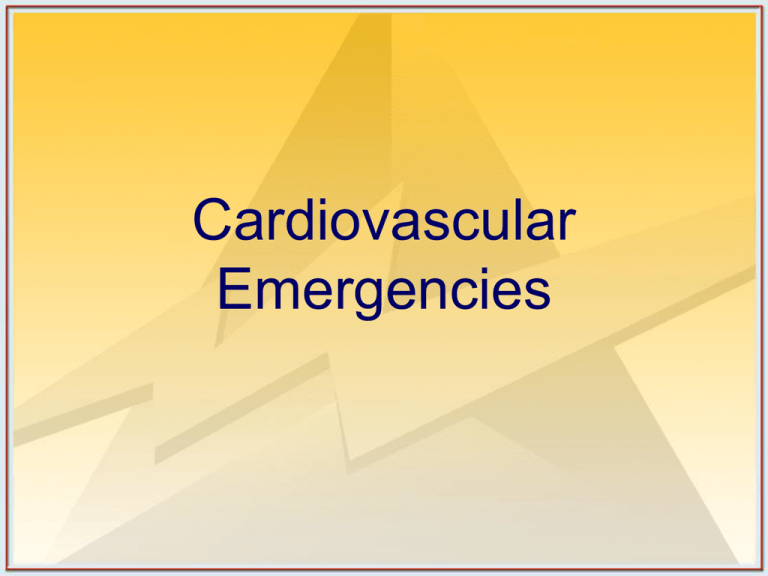
Cardiovascular Emergencies Objectives • Understand the causes and management priorities of bradycardia in children. • Identify risk factors for serious causes of syncope in children. • Describe the resuscitation and stabilization of a child presenting with cardiopulmonary failure. • List the strategies for prevention of submersion injuries in infants and children. Case Presentation • You are called to a suburban home for toddler found submerged in backyard pool. • A sobbing mother is performing CPR on 15-month-old girl on pool deck. • As you take over resuscitation, the mother tells you, “The phone rang; I was only gone for 5 minutes!” General Assessment: PAT Appearance Unconscious, unresponsive; poor muscle tone Work of Breathing No spontaneous respirations Circulation to Skin Ashen, cyanosis of hands and lips What is your general impression? General Impression and Management Priorities • General impression: – Sick: respiratory arrest; possible cardiorespiratory failure Unresponsive, apneic, abnormal circulation to skin – Physiologic problem: global hypoxemic–ischemic event • Immediate management: – Start oxygenation and ventilation while assessing for spontaneous circulation. Initial Assessment: ABCDEs • Airway — patent • Breathing —good air movement with bagmask ventilation; wet crackles on auscultation • Circulation — HR 20; femoral pulse barely palpable; capillary refill > 5 seconds; BP not obtained • Disability — pupils dilated, sluggishly reactive; unresponsive to pain • Exposure — no bruises, no signs of injury What is your overall assessment? Case Progression • Cardiopulmonary failure due to hypoxemia. – Chest compressions are indicated for HR < 60. • No evidence of associated injuries. – Consider spinal injury. Less likely in toddler submersion than with adolescent diving injury. – Consider nonaccidental trauma. No “red flags” What are your management priorities? Management Priorities • BLS: – Place on spine board. – Open airway; begin bag-mask ventilations, 100% 02. – Perform chest compressions. – Dry to prevent further heat loss/hypothermia. • ALS: – IV access, consider endotracheal intubation. – Epinephrine, 0.01 mg/kg IV/IO, or 0.1 mg/kg by endotracheal tube; repeat every 3–5 minutes. Transport Decision: Stay or Go? • BLS: – Rapid transport to nearest appropriate ED. – Continuous reassessment for return of pulse and circulation en route. • ALS: – Transport after airway/ventilation is secure, IV/IO access is established, and the first dose of epinephrine is given. – Do not delay transport if vascular access fails. Key Concepts: Bradycardia • Treatable causes of bradycardia with poor perfusion: – – – – – – – – Hypoxemia Hypothermia Hypovolemia Heart block Toxins, poisoning, drugs Tampondae, cardiac Tension pneumothorax Trauma (Head injury) Key Concepts: Bradycardia with Submersion Event • Bradycardia in near-drowning reflects significant hypoxia and myocardial ischemia. – The brain and other vital organs may also have suffered ischemic injury. – Rapid support of ventilation and oxygenation will reduce the risk of secondary injury. – The drug of choice is oxygen, followed by epinephrine. Key Concepts: Drowning Prevention • Pool drowning prevention: – Close supervision – Four-sided pool fence – Self-locking gate – Pool alarms • Open water drowning prevention: – Supervision of all age groups. – Use of personal floatation devices. – Educate teens about dangers of alcohol and water sports. • Risk awareness, as toddler drownings may occur in shallow water. Key Concepts: Injury Prevention • Multiple strategies are necessary for an effective injury prevention program. – Passive strategies – Legislative action – Enforcement of laws – Education Case Progression • Oxygen provided by bag-mask device, compressions continued. – After 30 seconds, the heart rate increases to 80 per minute and compressions are discontinued. – After 1 minute, the heart rate is 120 per minute; spontaneous respirations return. Case Progression • En route: – Supplemental oxygen is delivered by mask. – Blankets are applied to prevent heat loss. ED Course • In the ED: – The child shows progressive improvement in level of consciousness, asking for her mommy. – She remains hemodynamically stable. – SaO2 is 94% on 100 % O2, and chest X-ray shows diffuse infiltrates. – She is admitted to the pediatric intensive care unit and transferred to a ward the next morning. • Diagnosis: near drowning; pulmonary edema • Outcome: weaned from oxygen on day 2; home on day 4 with normal neurologic exam. Summary • Submersion results in hypoxia, leading to bradycardia, tissue ischemic injury, and eventually, cardiac arrest. • Early oxygenation and ventilation are the most effective ways to restore spontaneous circulation. • Prehospital management is a major determinant of outcome in children with submersion injury. • Submersion injuries are predictable — prevention is the best treatment! Case Presentation • You are dispatched to a middle-school athletic field for a child with loss of consciousness. • A 13-year-old boy is lying on the grass, receiving CPR by his coach. • The coach tells you that the child collapsed while running for a ball, and that “this has happened before.” What is the first thing you will do on arrival? General Assessment: PAT Work of Breathing No spontaneous respirations Appearance Unresponsive Circulation to Skin Pale, cyanotic What is your general impression? General Impression and Management Priorities • General impression: – Sick: cardiopulmonary failure Scenario suggests primary cardiac event. • Management: – BLS: apply AED. – ALS: “quick look” on monitor/defibrillator. Initial Assessment: ABCDEs • Since this was a witnessed collapse, attach the AED as soon as available. – Airway: patent – Breathing: no chest movement – Circulation: absent pulses, no heart sounds; shockable rhythm on AED, ventricular fibrillation (VF) on monitor – Disability: unresponsive to pain – Exposure: no bruising or signs of injury What is your overall assessment? Case Progression • VF cardiac arrest – Possible mechanisms: Primary cardiac disease Trauma (direct blow to precordium) Toxin/drugs What are your management priorities? Management Priorities • BLS: – – – – Establish absence of respirations, pulse. Turn on AED. Attach AED electrode pads. Analyze rhythm. Shock if advised, then resume CPR immediately for five cycles (2 minutes). If no shock is advised, resume CPR for five cycles (2 minutes). – Check for signs of circulation and rhythm every 2 minutes and repeat sequence from analyze rhythm. Management Priorities • ALS: BLS priorities plus: – Place on monitor, check rhythm. – Defibrillate. 2 joules/kg Resume CPR for five cycles (2 minutes), check rhythm; if VF, defibrillate with 4 joules/kg. – Resume CPR immediately. – Intubate, secure airway (optional). – Obtain vascular access. – Epinephrine 0.01 mg/kg (1:10,000) IV or 0.1 mg/kg ETT (1:1000); repeat every 3-5 minutes. – After five cycles (2 minutes); check rhythm. If shockable: – Defibrillate (4 joules/kg). – Resume CPR immediately. – Consider antiarrhythmic. Lidocaine 1mg/kg IV/IO/ET Amiodarone 5 mg/kg IV/IO Transport Decision: Stay or Go? • Stay on scene and treat until a pulse is established or the child is asystolic. • As in adults, the outcome is strongly linked to resuscitation in the field. – Survival statistics are poor for a child brought to the ED in asystole. Key Concepts: Ventricular Fibrillation • Airway management and correction of hypoxia while making rhythm diagnosis is critical. • Although pediatric VF is uncommon, early recognition and treatment improve the chance of successful resuscitation. – Early defibrillation increases the survival rate. • Increased availability and use of AEDs in community can improve outcomes for both pediatric and adult VF victims. Key Concepts: High-risk Groups/Causes for VF • Cardiomyopathies • Coronary artery abnormalities: – Post-Kawasaki disease aneurysms, thrombi – Congenital anomalies • Direct blow to chest • Dysrhythmia syndromes Key Concept: Identifying Cardiac Syncope • Most fainting spells are benign, but “red flags” can identify serious cardiac causes. – Was the episode associated with chest pain? – Was there a brief or absent aura? – Were there palpitations prior to fainting? – Did it occur during exercise? – Is there a family history of sudden death? Case Progression • At scene: – Rescue breathing and cardiac compressions started. – AED shows VF — converted to NSR on second shock. – Vascular access obtained • En route: – Lidocaine bolus 1 mg/kg IV and then 20 micrograms/kg/min infusion or bolus every 15 minutes – Continues in sinus rhythm ED Course • In the ED: – Lead 2 rhythm strip shows QTc = 0.52 – The mother arrives and reports three prior brief episodes of exerciseassociated syncope; sudden death at the age of 28 in uncle. • Outcome: child diagnosed with long QTc syndrome. A pacemaker is placed. The patient is discharged neurologically intact 5 days later. Summary • Most episodes of syncope in children are benign. • Ventricular fibrillation is a rare cause of loss of consciousness in pediatrics. • Early recognition of VF and defibrillation improve survival rates. • When VF is diagnosed, standard cardiac resuscitation protocols should be followed, regardless of the age of the patient. Summary • The primary cause of cardiopulmonary arrest in children is severe hypoxia associated with respiratory failure. – Asystole or profound bradycardia is the most common arrest rhythm on EMS arrival. • Rapid intervention and return of vital signs in the field are associated with good outcome. – Patients with ventricular fibrillation who have return of sinus rhythm have good survival rates. – Children with asystole as the presenting rhythm on scene rarely survive.
